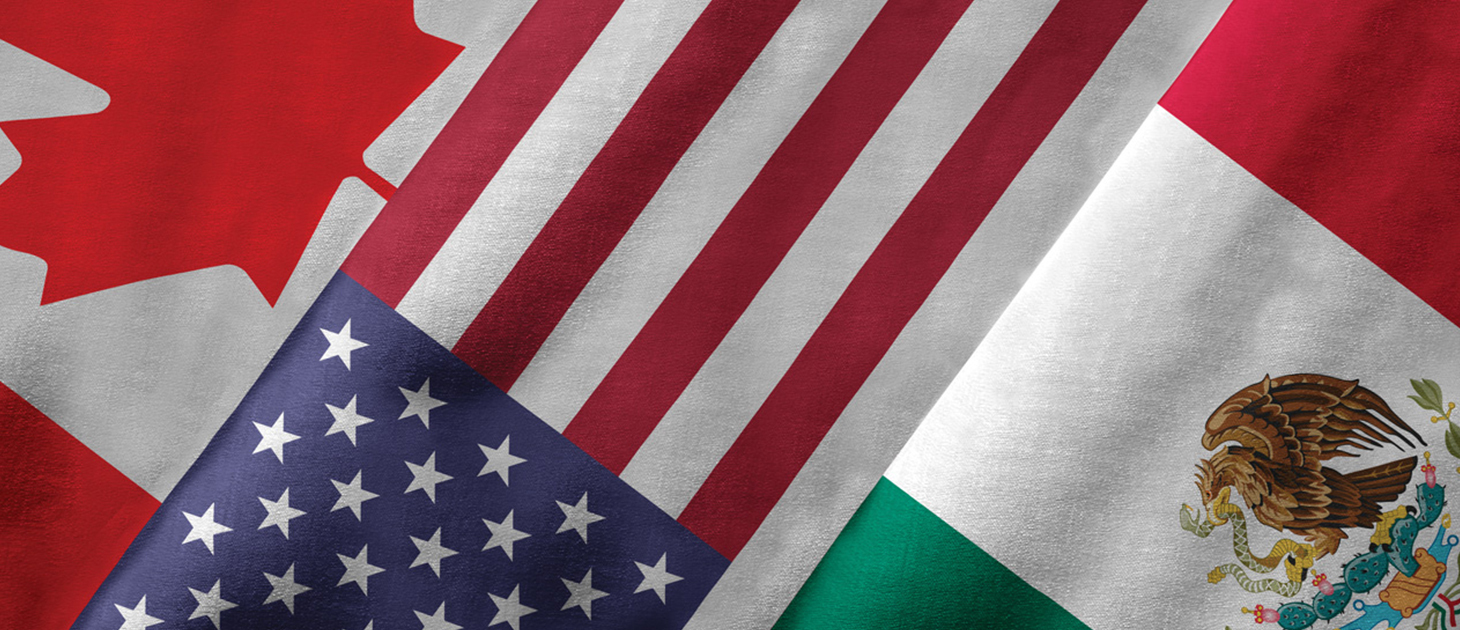For Manufacturers, U.S. Trade Policy Yields Mixed Results
The new North American trade pact could make some goods produced in the U.S. less competitive, but thawing Chinese relations could provide uplift.

This story originally appeared in the May/June 2020 print edition of Middle Market Growth magazine. Read the full issue in the archive.
The Trump administration has distinguished itself from its predecessors by reshaping the nation’s trade policy in ways that have proved to be both a boon and burden for American manufacturers.
In response to the updated trade pact between the U.S. and its neighbors and tariffs on Chinese imports, middle-market companies are adapting to a new trade regime and adjusting their operations accordingly.
One of the president’s earliest trade objectives was to overhaul the North American Free Trade Agreement, a promise he made on the campaign trail. In October 2018, negotiators revealed the text of the revised pact, known as the United States-Mexico- Canada Agreement, or USMCA.
“The USMCA is going to serve to raise the costs of North American automobile manufacturers.”
Harry Broadman
Managing Director and Chair of Emerging Markets Practice, Berkeley
Research Group LLC.
The document’s automotive provisions are some of its most significant features and reflect how the industry has changed over the last 25 years.
Since NAFTA was established in 1994, there are now more automotive components produced using a wider variety of manufacturing techniques, and they rely more heavily on global supply chains, according to Harry Broadman, who participated in NAFTA negotiations as U.S. assistant trade representative during the Bush and Clinton administrations and is now managing director and chair of the Emerging Markets Practice at Berkeley Research Group LLC.
In order to qualify for preferential tariff treatment under NAFTA and USMCA, products must meet certain thresholds for materials that originate in the U.S., Canada or Mexico. Under NAFTA, 62.5% of an automobile had to come from within the trading bloc. Under USMCA, that threshold is 75%.
The USMCA also requires that at least 70% of the steel and aluminum used in a vehicle must come from North America. NAFTA didn’t include provisions governing these materials.
The new agreement also includes new labor provisions for automakers and suppliers. At least 40% of a vehicle’s parts must be produced by workers who make a minimum of $16 per hour, which is meant to incentivize American companies to relocate operations back into the U.S. from Mexico.
Broadman says that although the intention behind the Trump administration’s revised trade agreement is to make the U.S. more competitive within the trading bloc, it could have the opposite effect in other geographies.
“The USMCA is going to serve to raise the costs of North American automobile manufacturers,” Broadman says, adding that the elevated wage requirements in the agreement are designed to reduce Mexican firms’ competitive edge over American producers. But he argues the higher wages will erode North America’s ability to compete globally. “That’s the fly in the ointment,” he adds.
With the USMCA completed, U.S. Trade Representative Robert Lighthizer has said the administration will seek to update trade agreements with the European Union and the United Kingdom, using the North American trade pact as a template. “[Lighthizer] sees the USMCA as a model to shop around the world,” Broadman says.
Whether or not the USMCA is applied to other trade agreements negotiated by the U.S. will depend on its success in making the American automotive industry more competitive.
On March 13, Canada became the third and final country to ratify the USMCA. The agreement is expected to go into effect early this summer.
Tariffs Prompt Shift from China
While the sun rises on one trade issue, it sets on another.
The U.S. and China have taken the first steps to end an escalating trade war that’s caused considerable disruption for more than two years, while middle-market companies assess the damage and look ahead to new risks.
On Jan. 15, the U.S. and China signed a “phase one” trade deal that is expected to tee up future talks on intellectual property, technology transfer, financial services, currency policy and dispute resolution.
As part of the agreement, China pledged to increase its purchases of U.S. goods. In return, the U.S. has rolled backed some of its tariffs. The pause in brinksmanship has injected confidence for middle-market companies in the U.S., says Peter Cogan, a managing partner at accounting firm EisnerAmper.
“The re-opening of trade between China and the U.S. with fair terms to both sides should strengthen the U.S. economy and spur growth in U.S. production of goods,” he says.
“The re-opening of trade between China and the U.S. with fair terms to both sides should strengthen the U.S. economy and spur growth in U.S. production of goods.”
Peter Cogan
Managing Partner, Eisner Amper
The timing and contents of the next phase of the agreement are yet to be decided, and disruption caused by the coronavirus outbreak has dampened prospects for cross-border trade volume this year.
The trade war with China has been costly for U.S. manufacturers. Since February 2018—around the time that the Trump administration announced the first round of tariffs—American companies have spent approximately $46 billion on duties on imports from China, according to analysis by Tariffs Hurt the Heartland, a coalition that represents business and agriculture groups.
Pivot International, a product designer and manufacturer based in Lenexa, Kansas, has watched the trade war unfold. “We were in the middle of this and have been since it started,” says President and CEO Mark Dohnalek.
Pivot had to triple the size of its global supply chain staff when the trade restrictions went into effect. “It took a lot more resources to pull off the same amount of work,” Dohnalek says. “So we paid for it in some ways.”
The company, whose products span a wide range of industries, was able to minimize its exposure to the trade war because of its diverse holdings across Asia.
Since 1987, Pivot has had a presence in the Philippines, where it concentrates its manufacturing in Asia, and it maintains a design office in Taiwan. By operating outside of China, Pivot was able to avoid direct exposure to the increased import duties in the U.S.
The company sources components throughout Asia, so when the trade dispute began, Pivot sought a few new vendors to mitigate risk. “We’ve been able to function very much like a large multinational corporation in a way,” Dohnalek says.
Many midsize businesses with a presence in Asia stick with one country—often China. Since the beginning of trade tensions, that thesis is being challenged.
“This reminds everybody why they can’t do single-sourcing for their supply chain in Asia,” Dohnalek says. “You have to have a backup supplier and multiple manufacturers. I think this will truly put that in place philosophically.”
Coupled with disruption from the COVID-19 outbreak, which began in the Chinese city of Wuhan, it’s becoming increasingly difficult for U.S. companies to justify concentrating their supply base in China. That could drive a wedge in the country’s dominance as a global manufacturing hub.
In March, the National Association of Manufacturers released survey results showing that more than half of respondents expect to alter their supply chains as a result of the coronavirus outbreak.
Manufacturers with government contracts may have yet another reason to broaden their supply network, as the U.S. government explores ways to restrict Chinese goods entering the country. White House trade adviser Peter Navarro said in March that the Trump administration was considering “buy American” laws that would require federal agencies to purchase American-made products in certain industries.
“China will always be a vital part of the global supply chain,” Dohnalek says. “But it’s going to be blended going forward. I don’t think you’re ever going to put that genie back in the bottle.”

Benjamin Glick is Middle Market Growth’s associate editor.


